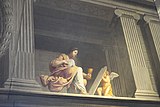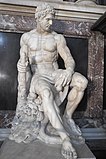Chapelle de la Visitation (Moulins)
The Chapelle de la Visitation , also Chapel Saint-Joseph , in Moulins , the capital of the Allier department in the French region of Auvergne-Rhône-Alpes , was built in the 17th century as a chapel of the Order of the Visitation of Mary . The tomb of Duke Henry II of Montmorency (1595–1632) is located in the chapel , while ceiling paintings from the construction period have been preserved in the nurses' choir. In 1928, the chapel was added to the list of architectural monuments ( Base Mérimée ) in France as Monument historique .
history
The Order of the Visitation of Mary was founded in 1610 by Franz von Sales and Johanna Franziska von Chantal in Annecy . In 1616, after Annecy and Lyon , the third branch of the order was established in Moulins, where Johanna Franziska von Chantal died on a visit in 1641. The sisters, also known as the visitants , initially lived in modest houses, which at that time were still outside the medieval city wall. After the execution of Henry II of Montmorency in 1632, his widow, Maria Felicia Orsini (1600–1666), found refuge with the Visitation Sisters in Moulins. She was first placed under house arrest in the castle of the Dukes of Bourbon until she was arrested by the French King Louis XIII in 1636 . was given permission to retire to the monastery of the Visiting women. In 1665 she became their superior .
From 1648, the Duchess of Montmorency, out of gratitude for her acceptance into the order, had new monastery buildings and the chapel built, which were completed by 1655. During the French Revolution , the monastery was dissolved and in 1802/03 a school, the Lycée Théodore-de-Banville, was built on the site of the former monastery buildings. Only the chapel that was used as a school chapel until 1998 remained from the monastery of the Visitation Women.
architecture
Portal facade
The facade facing the Rue de Paris, one of the most important traffic routes in Moulins at the time, is characterized by colossal pilasters and a triangular gable with the order's coat of arms. A rose window opens in the middle of the facade , the portal has carved wooden door leaves from the construction period.
inner space
The two-bay nave has a single nave and is covered by a ribbed vault. The side walls are structured by pilasters with Ionic capitals and arched arcades that open to narrow chapels. The square choir has just closed and is vaulted by a dome. The tomb of the Duke of Montmorency is housed in a niche in the choir. To the north of the choir of the chapel is the sister choir, which was connected to the monastery buildings and the apartments of the Duchess of Montmorency.
Ceiling painting
The nurses' choir is covered by a flat wooden ceiling in which 17 scenes from the life of the Virgin Mary painted on canvas are integrated. The Assumption of Mary is depicted on the large central tondo , the Immaculate Conception , the birth of Mary , the flight to Egypt and the death of Mary on the four square images . The allegorical representations of virtues and good deeds such as hope, faith, innocence, prayer, Christian charity, piety, humility and diligence are embedded in the sloping ceilings between illusionistic architectural elements. The depictions of Mary of the Annunciation scene and the risen Christ are framed by medallions. The two oval pictures show the passage of Mary to the temple and the presentation of Jesus in the temple .
The execution of the painting, formerly attributed to Eustache Le Sueur , is, according to recent research, attributed to Rémy Vuibert , a pupil of Simon Vouet , who stayed in Moulins frequently between 1649 and 1650. In 1651 the Duchess of Montmorency commissioned the decoration with the theme of the Glorification of Mary. In 2008, the paintings, which were damaged in a fire in 1797, were extensively restored.
Tomb of the Duke Henry II of Montmorency
The tomb, also known as the mausoleum , commemorates Henry II of Montmorency, the last Duke of the House of Montmorency . As peer , marshal and admiral of France and governor of Languedoc, he was one of the most important personalities of the kingdom. Because of his participation in an uprising in his province against Cardinal Richelieu and the French King Louis XIII. he was sentenced to death in Toulouse in 1632 and beheaded.
His widow had the tomb made in Paris from 1648 and placed in the Chapel of the Visitantinnen in Moulins in 1653. The sculptors were François Anguier and his brother Michel , Thibault Poissant and Thomas Regnaudin . In the middle, Henry II of Montmorency and his wife Maria Felicia Orsini are shown lying on a sarcophagus with an upright torso . The Duke is dressed in armor, his right arm is leaning on his helmet, and he is holding his sword in his left hand. Maria Felicia Orsini is dressed in a long, pleated robe. She has folded her hands in prayer, her expression is marked with pain. On the left is the figure of the Roman god of war Mars , next to the sarcophagus sits Hercules with a club in his right hand and a snake in his left hand and the skin of the Nemean lion at his feet. Both figures are supposed to symbolize the duke's bravery. The two female figures on the right, allegorical representations of faith and Christian charity ( Caritas ), embody the virtues of his wife. All figures are carved from Carrara marble . Above the tomb is the coat of arms of the Duke of Montmorency, held by two angels, on which 16 eagles are depicted and which is surrounded by the chains of the Order of Michael and the Order of the Holy Spirit , of which the Duke was a member.
Furnishing
The altarpiece with the depiction of Mary's temple passage is attributed to the workshop of Rémy Vuibert. Since the painter suddenly died of an epidemic in 1652, it was not completed by himself. Most of the people in the picture have features of members of the Orsini family.
literature
- Le Patrimoine des Communes de l'Allier . Flohic Éditions, Volume 2, Paris 1999, ISBN 2-84234-053-1 , pp. 884-886.
Web links
- La chapelle de la Visitation
- Lycée Théodore-de-Banville à Moulins
- Chapelle de la Visitation à Moulins
Individual evidence
- ↑ Chapelle de la Visitation in the Base Mérimée of the French Ministry of Culture (French)
- ↑ Peinture monumentale in the Base Palissy of the French Ministry of Culture (French)
- ↑ Tombeau d'Henri II, duc de Montmorency in the Base Palissy of the French Ministry of Culture (French)
- ↑ La Présentation de la Vierge au Temple in the Base Palissy of the French Ministry of Culture (French)
Coordinates: 46 ° 34 ′ 7.7 " N , 3 ° 19 ′ 47.3" E















